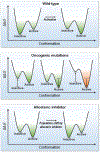Inhibition of Nonfunctional Ras
- PMID: 33440168
- PMCID: PMC7897307
- DOI: 10.1016/j.chembiol.2020.12.012
Inhibition of Nonfunctional Ras
Abstract
Intuitively, functional states should be targeted; not nonfunctional ones. So why could drugging the inactive K-Ras4BG12Cwork-but drugging the inactive kinase will likely not? The reason is the distinct oncogenic mechanisms. Kinase driver mutations work by stabilizing the active state and/or destabilizing the inactive state. Either way, oncogenic kinases are mostly in the active state. Ras driver mutations work by quelling its deactivation mechanisms, GTP hydrolysis, and nucleotide exchange. Covalent inhibitors that bind to the inactive GDP-bound K-Ras4BG12C conformation can thus work. By contrast, in kinases, allosteric inhibitors work by altering the active-site conformation to favor orthosteric drugs. From the translational standpoint this distinction is vital: it expedites effective pharmaceutical development and extends the drug classification based on the mechanism of action. Collectively, here we postulate that drug action relates to blocking the mechanism of activation, not to whether the protein is in the active or inactive state.
Keywords: K-Ras4B; KRAS; dimer; drug discovery; energy landscape; inhibitor; kinases.
Copyright © 2021 The Authors. Published by Elsevier Ltd.. All rights reserved.
Conflict of interest statement
Declaration of Interest
The authors declare no conflict of interest.
Figures



Similar articles
-
Drugging Ras GTPase: a comprehensive mechanistic and signaling structural view.Chem Soc Rev. 2016 Sep 21;45(18):4929-52. doi: 10.1039/c5cs00911a. Epub 2016 Jul 11. Chem Soc Rev. 2016. PMID: 27396271 Free PMC article. Review.
-
The Structural Basis of Oncogenic Mutations G12, G13 and Q61 in Small GTPase K-Ras4B.Sci Rep. 2016 Feb 23;6:21949. doi: 10.1038/srep21949. Sci Rep. 2016. PMID: 26902995 Free PMC article.
-
Inhibition of RAS: proven and potential vulnerabilities.Biochem Soc Trans. 2020 Oct 30;48(5):1831-1841. doi: 10.1042/BST20190023. Biochem Soc Trans. 2020. PMID: 32869838 Free PMC article. Review.
-
Revealing the mechanism of action of a first-in-class covalent inhibitor of KRASG12C (ON) and other functional properties of oncogenic KRAS by 31P NMR.J Biol Chem. 2024 Feb;300(2):105650. doi: 10.1016/j.jbc.2024.105650. Epub 2024 Jan 16. J Biol Chem. 2024. PMID: 38237681 Free PMC article.
-
In situ selectivity profiling and crystal structure of SML-8-73-1, an active site inhibitor of oncogenic K-Ras G12C.Proc Natl Acad Sci U S A. 2014 Jun 17;111(24):8895-900. doi: 10.1073/pnas.1404639111. Epub 2014 Jun 2. Proc Natl Acad Sci U S A. 2014. PMID: 24889603 Free PMC article.
Cited by
-
The Importance of Mg2+ -Free State in Nucleotide Exchange of Oncogenic K-Ras Mutants.Chemistry. 2022 Oct 21;28(59):e202201449. doi: 10.1002/chem.202201449. Epub 2022 Sep 1. Chemistry. 2022. PMID: 35781716 Free PMC article.
-
Neurodevelopmental disorders, immunity, and cancer are connected.iScience. 2022 May 30;25(6):104492. doi: 10.1016/j.isci.2022.104492. eCollection 2022 Jun 17. iScience. 2022. PMID: 35712080 Free PMC article. Review.
-
CDK2 and CDK4: Cell Cycle Functions Evolve Distinct, Catalysis-Competent Conformations, Offering Drug Targets.JACS Au. 2024 May 14;4(5):1911-1927. doi: 10.1021/jacsau.4c00138. eCollection 2024 May 27. JACS Au. 2024. PMID: 38818077 Free PMC article.
-
Allostery, and how to define and measure signal transduction.Biophys Chem. 2022 Apr;283:106766. doi: 10.1016/j.bpc.2022.106766. Epub 2022 Jan 29. Biophys Chem. 2022. PMID: 35121384 Free PMC article. Review.
-
Mechanism of activation and the rewired network: New drug design concepts.Med Res Rev. 2022 Mar;42(2):770-799. doi: 10.1002/med.21863. Epub 2021 Oct 25. Med Res Rev. 2022. PMID: 34693559 Free PMC article. Review.
References
-
- Adams B, (2020). Eli Lilly crashes out of KRAS race as toxicity sees it ditch phase 1 effort. https://www.fiercebiotech.com/biotech/eli-lilly-crashes-out-kras-race-as...
-
- Adjei AA (2001). Blocking oncogenic Ras signaling for cancer therapy. J Natl Cancer Inst 93, 1062–1074. - PubMed
-
- Azam M, Latek RR, and Daley GQ (2003). Mechanisms of autoinhibition and STI-571/imatinib resistance revealed by mutagenesis of BCR-ABL. Cell 112, 831–843. - PubMed
Publication types
MeSH terms
Substances
Grants and funding
LinkOut - more resources
Full Text Sources
Other Literature Sources
Miscellaneous

